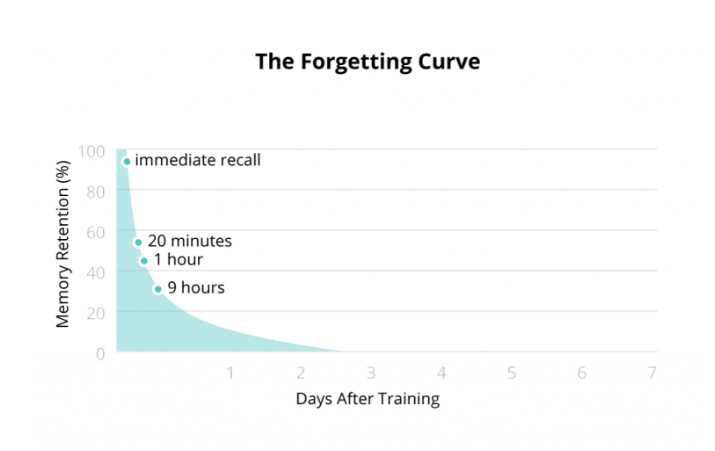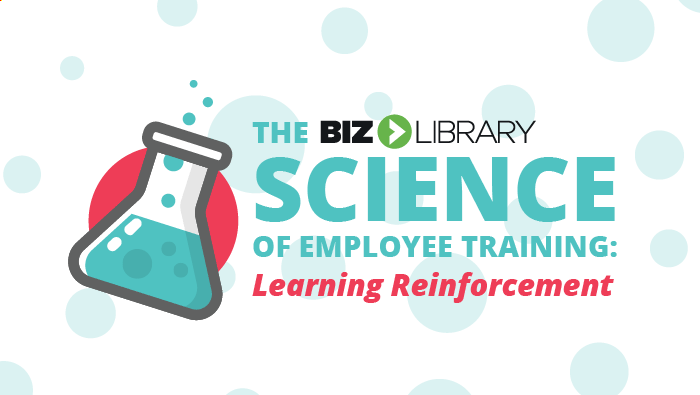Let’s pretend you’re at a seminar – the speaker is engaging, the presentation is interesting, and you feel like you learned something new that you can apply to your job.
How much do you think you’ll remember the next day?
All of the information? Half of the information? How about a third?
Scientific research shows that people forget about 70% of new information within 24 hrs.
Shocking, isn’t it?
What’s more shocking is that Americans spent an estimated $83 billion dollars in corporate training in 2019.
Statistics like these show the desperate need to ensure employee training methods account for natural processes in memory and knowledge retention rates.
How confident are you that your training is within the 30% of what your employees’ memory deems most important to hold onto that day?
As a training and development professional, you want to maximize your training ROI, and you want to make sure that employees retain and apply what they’ve learned on the job.
The good news is there are many things you can do to improve learning retention.
Check out this infographic for a quick overview on learning retention rates and statistics:
But before we go any further, let’s dispel a couple myths about memory and learning retention first:
Learning Retention Myth #1: “Forgetting is the failure of memory”
Neuroscientists say that forgetting is adaptive. We live in a fast-paced, busy world that is constantly feeding us new information.
Television, news, media and advertisements are all around us every second of the day. In response, the brain appropriately filters out information that is no longer being used, and that is no longer important.
Forgetting is not a failure of memory – on the contrary – it is a fundamental part of the entire memory system. It is an active, normal and desirable component that helps us learn what really matters and forget what doesn’t.
Learning Retention Myth #2: “If the information is relevant, people will remember it”
While some people might think that if a piece of information is important to us, we will hold on to it a little longer, that’s often not the case.
People forget 70% of new information within 24 hours regardless of what the information is. It affects everyone the same way. Forgetting works independently of phenomena such as IQ, age, and relevance.
How confident are you that your training is within the 30% of what your employees’ memory deems most important to hold onto that day?
Why Learning Retention Matters to Organizations Today
Research on retention of information dates back to the 1800s, when German psychologist Herman Ebbinghaus developed the forgetting curve. It shows how people quickly forget new knowledge within hours after learning it.

This process of the memory purging information to retain only the most important things has been studied and observed many times over.
Even though it isn’t a new topic of study, it is quickly becoming more relevant to businesses these days.
Here’s why.
As more and more organizational leaders see the value in providing ongoing development opportunities to their employees, and the amount of money spent on training and development grows, there comes a time when training professionals have to stop and ask themselves the big questions about learning and retention:
“How do we know if this training program is really working?”
“How can I prove to C-level executives that this investment is worth it?”
Improving ROI for Corporate Training Programs
For some organizations, linking training and development to strategic goals and increased business performance may be easy, but that is not the case for many others.
Like it or not, employees simply completing the training is not enough – in fact, it’s not even close.
We already know practice and repetition is needed to learn new skills, so shouldn’t it be applied to employee learning, too?
Learning retention statistics are a hard pill to swallow, especially when your role involves many hours spent on planning and administering a training program or creating custom content.
But the good news is that you can do something about it!
By providing learners with opportunities for effortful retrieval after completing a training video or lesson, you can reset the forgetting curve and improve learning retention rates.
So what exactly is “an opportunity for effortful retrieval” and how does that work?
Effortful retrieval simply means giving learners a chance to recall the new information.
In neuroscience, learning is called “encoding.” This is a one-time process that stores new information in the brain. To improve retention, learners only need to retrieve that information.
Even talking or thinking about it serves as a boost to the brain that resets the forgetting curve.
For example, football players are required to practice almost every day, and for many hours, because true retention and transfer requires learning, practice, and repetition. It’s the same for musicians. They practice and practice for hours until they know music and lyrics by heart. call it, retention learning.
We already know practice and repetition is needed to learn new skills, so shouldn’t it be applied to employee learning, too?
Overcoming the Forgetting Curve With Boosts
Many of the videos in our content library have “boosts,” or opportunities to reengage with the content and reinforce what information was learned.
With our platform, once a learner completes select video lessons or courses, they are given the option to enroll in boosts. The feature includes four opportunities for effortful retrieval (boosts) in the form of a poll question, a fill-in-the-blank question, a multiple choice question, or an open-ended thought question.
These short boosts are delivered via email and prompt learners to recall specific points from the recently completed lesson, which tells the brain, “Oh, this is important information, I need to keep this!”
With each boost, retention improves, so when the time comes to apply the training to their work, that knowledge is ready for retrieval!
Here’s an example to better portray how this process would work:
Let’s say you have been experiencing low close rates among your sales reps.
You have assigned them a video lesson on “Closing the Sale” in the past, but guess what… within 24 hours of them completing that course, they forgot most of what they learned.
Now, suppose you assign them the lesson again and upon completion of the lesson, they are enrolled in the booster program.
Over the next two weeks, they receive the three initial boosts that help them reinforce the key learning points from the video lesson.
The fourth and final boost is a thought question, which asks the learner to summarize in their own words how “Closing the Sale” has helped them improve their skills as a sales rep.
Your rep with the lowest close rate to date responds:
“I have been able to use the tips provided in the video lesson and have changed my communication style during final calls. I now understand the importance of owning the sales process and have closed two new deals because of that lesson.”
Well that sounds like a direct connection between employee training and increased business performance!
This is just one example, but imagine if you could start seeing results like this for entire teams and departments.
When you can point to how training has directly correlated with positive business results, your organization can make stronger, data-driven decisions about investing in employee learning solutions.


